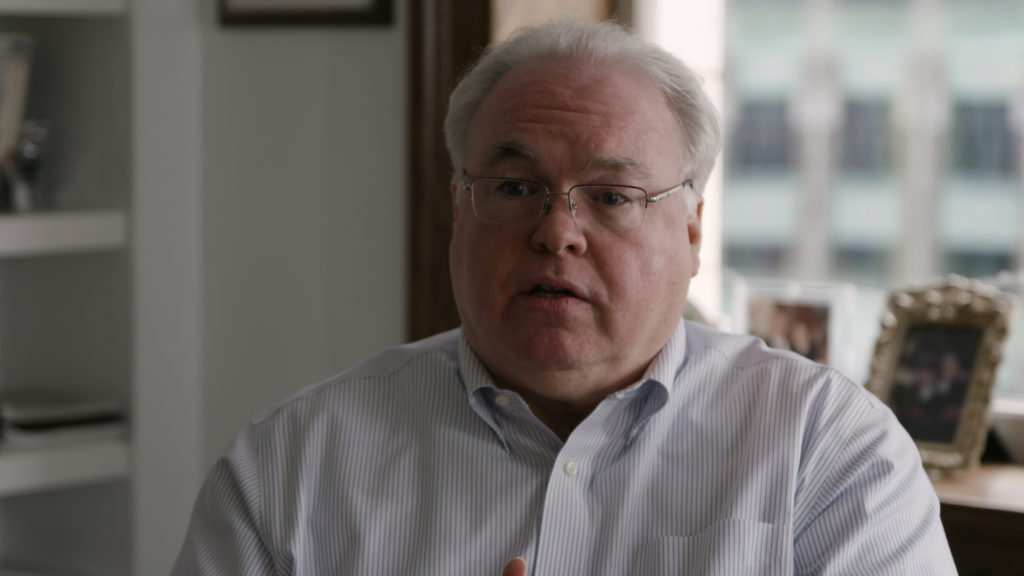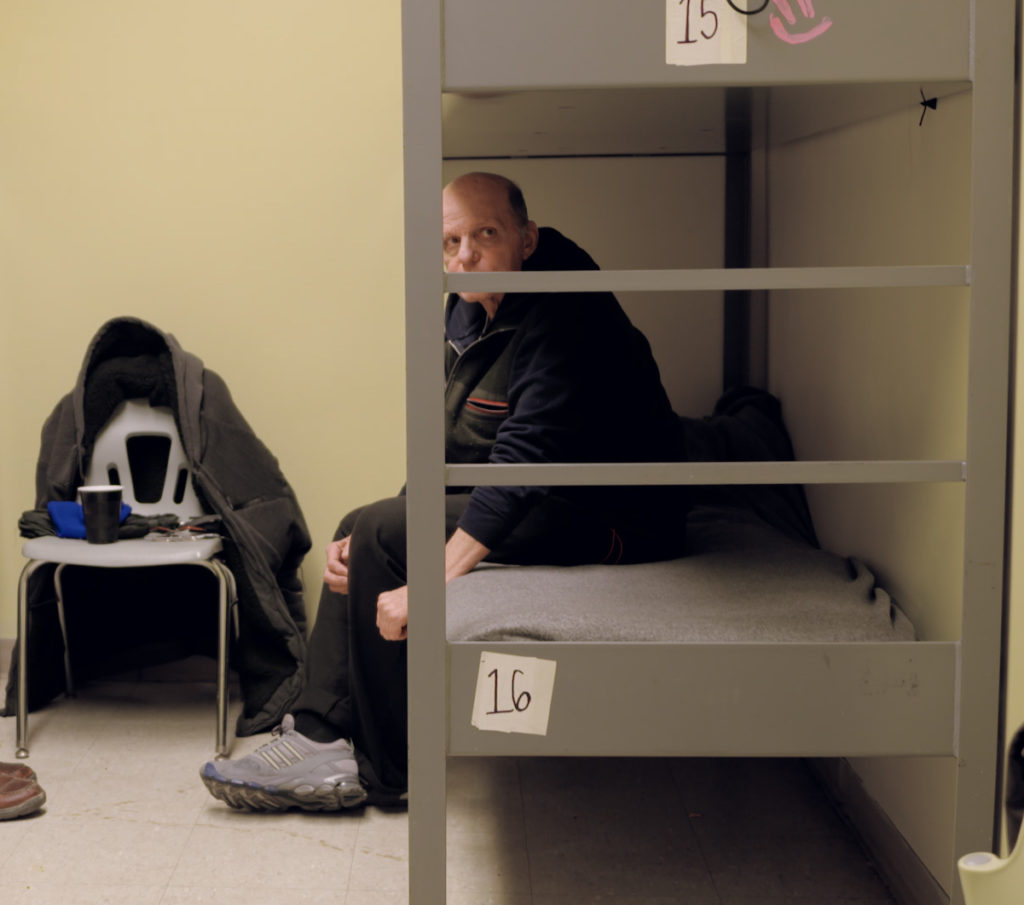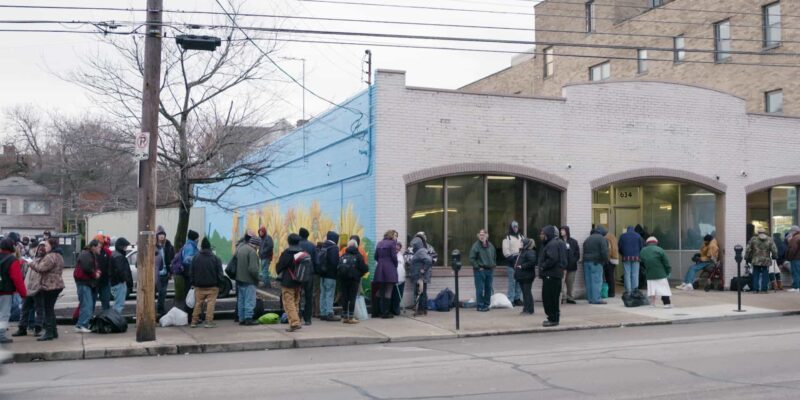This article was a collaboration between the Center for Public Integrity and Newsy.
Introduction
COVINGTON, Ky. — They are among the unlikeliest victims of President Donald Trump’s new tax law, these folks who start to line up at 5 p.m. in front of a pseudo-mission-style building with a mural of sunflowers on a side wall. But victims they may soon be.
As the hour passes, men and women — white, African American, and others — join the queue, which begins to snake down Scott Street towards a beaming yellow sign with red lettering trumpeting Lee’s Famous Recipe Chicken & Strips.
Some are soaked from the cold rain that was falling earlier in the day; the temperature hovers just above freezing. It feels like snow, but it hasn’t begun to fall — yet. The folks here are anxious to get inside, but not just to avoid the weather; the real appeal is one of the neatly made up metal-frame beds and the plate of fried chicken that awaits.
November through March, the scene repeats itself daily at the Emergency Shelter of Northern Kentucky in Covington, which during the summer offers a housing program for working men, and shower and laundry facilities. Every night, this shelter just across a swollen Ohio River from Cincinnati takes in 75 “guests,” as the staff refers to them. The shelter will take in more if the temperature drops below freezing, and that will happen tonight.
This facility is “low barrier,” as they say in homeless-policy speak, meaning anyone is admitted — even if they are in active addiction, afflicted with mental illness, disabled or have a criminal record. The shelter serves the three northernmost counties in Kentucky, home to 389,000 people, but some clients cross the nearby bridges from Ohio to come here. It’s a warm, dry place to sleep and for some a ray of hope for recovery or a place to ease suffering and fear. One guest entering the doors this night has stage four prostate cancer. Another says through tears the shelter protects her from the streets where she says she has fought off attempted rapes.
“We believe everyone deserves a bed at night,” said Kim Webb, the executive director of the shelter. “Just come in the door tonight — we’re going to clothe you, and you’re going to get in line for the shower. … In that moment, absolutely we are lifesaving.”
But for the Covington homeless, and for more than a half-million like them, two-thirds of whom file into similar shelters nationwide every night, the future of those warm beds and chicken dinners is now threatened thanks to an improbable culprit: the Tax Cuts and Jobs Act signed by Trump more than a year ago. Among many of the law’s tax changes, most of which benefited the wealthy, was the doubling of the standard deduction to $24,000 for married couples and $12,000 for individuals. The idea was to simplify filing taxes, at the same time to give a tax cut to low- and middle-income Americans.

The boost in the deduction may indeed accomplish those goals. But one of the consequences, says Webb and other social advocates like her, is that fewer taxpayers will any longer have the financial incentive to itemize their deductions of cash and gifts to charities — and donations will drop. For many, the higher standard deduction will exceed all other deductions when combined — mortgage interest, state and local taxes, and charitable contributions, for example. Many, it seems, are beginning to cut back on giving. The fear is that more donors, as they learn this tax-filing season that it’s not financially worthwhile to itemize, will follow suit later this year.
It’s not like Republicans, who passed the tax law in December 2017 without one vote from Democrats, didn’t see this coming. Sen. John Thune, a South Dakota Republican who sat on the Finance Committee when it ushered the tax legislation through, said in 2017 months before Congress considered the tax bill that he had concerns with doubling the standard deduction.
“I think from the charitable community, what that’s likely to do is to create fewer itemizers and if you’re not itemizing, there’s a lot less incentive” to give, Thune said.
Was anyone listening?
Smaller donations drop
The early returns on the amount of donations to nonprofits are less than conclusive, but for Webb and those like her, they are unsettling. Giving to nonprofits nationwide in 2018, the first year the tax law was in effect, was up a slight inflation-adjusted 1.6 percent because of larger gifts. But that represented a much lower boost than the 8 percent gain charities reported in 2017, according the Fundraising Effectiveness Project, a group jointly created by the Association of Fundraising Professionals and the Urban Institute to help nonprofits increase donations.
For some, the report proves the tax law is working. Rep. Kevin Brady, R-Texas, who shepherded the bill through the House in 2017 as chairman of the Ways and Means Committee, cited in an email the project’s finding that donations of “at least $1,000 increased nearly 3 percent.” (The project reported a 2.6 percent increase in donations of $1,000 or more.)
“History shows that higher giving is driven by a stronger economy — and that is exactly what our new tax code is producing,” Brady said. “Doubling the standard deduction while lowering tax rates across the board gave our families first say over their money to spend or donate as they see fit, and that will continue to lift all sectors of this growing economy.”
Former Sen. Orrin Hatch, R-Utah, chairman of the Finance Committee when the Senate was considering the tax bill, didn’t respond to a request for comment.
But what’s troubling, those who follow charitable giving say, is that the amount from smaller donations decreased. The revenue charities collected from donors who gave less than $250 dropped 4.4 percent in 2018 compared with 2017, and those who gave $250 to $999 dropped 4 percent, according to the project’s analysis, which was based on a panel of more than 4,500 charities.

Donations in the fourth quarter of 2018, when givers typically donate as they think of tax implications, dropped even more, with donations of $250 or less falling 15 percent. A large stock market decline in December and donors giving more in 2017 to take advantage of itemizing before the tax law took effect may have inflated giving that year. But the numbers worry nonprofit experts, nonetheless.
“We told our members early in 2018 that major gifts probably wouldn’t be affected significantly because most major donors aren’t worried about an increase in the standard deduction — they’re already itemizing,” said Michael Nilsen, the project’s spokesman. “But it’s the mid- and lower-level gifts where we thought there would be some potential problems, and that’s exactly what happened.”
That hurts the small- to mid-size charities that offer services to the poor — shelters, health clinics, food banks and childhood services — and that generally rely on givers who aren’t that well off. Wealthy donors, a larger percentage of whom will continue to itemize their deductions, are more likely to give to nonprofits that serve the arts, large medical facilities, private secondary schools and universities.

“The preliminary data is showing for the small- to mid-sized nonprofits, they’re the ones suffering the most. That’s not saying all of them are, but it is to say that there seems to be a significant number who are,” said Tim Delaney, president and chief executive of the National Council of Nonprofits, an association in Washington, D.C. “So, if the money’s not coming in, that means that they are going to have to look at cutting some services.”
Before the tax code change, more than 17 percent of middle-income earners — those making between $48,600 and $86,000 — benefited from itemizing their charitable deductions, the Tax Policy Center, a nonpartisan think tank in Washington, D.C., estimated last year. After the tax law went into effect, only 5.5 percent of taxpayers earning that amount are better off by itemizing their charitable giving.
On the backs of the needy
Back in Covington, Webb said the amount the shelter has received from online giving is running behind the previous year: $49,650 compared with $55,230. Only three months remain in the fiscal year, a time that is harder to raise money because the months are warmer and city residents aren’t thinking of homeless people sleeping outside in the cold, Webb said. The shelter’s budget this year is more, however, $426,000 compared with $330,000, due to other sources of income, Webb said.
What worries Webb is that people are realizing now that it won’t be financially beneficial to them to itemize their 2019 taxes and therefore won’t give this year. Webb said she is troubled by the chatter she’s hearing from donors that they may not give as much and wonders how many others she hasn’t heard from that are thinking the same way. “It is a major concern for me, as the unknown effects could be devastating to the guests we serve,” she said.
One donor Webb has heard from is Julie Pile, a 49-year-old mother of two who lives in a modest neighborhood just outside Covington. Pile began giving to the shelter years ago when she started volunteering there and she learned how many students at her children’s school were homeless — “more than anyone can ever imagine,” she said.

In years past, Pile has itemized her deductions to offset her income from her job as a social media consultant but said she and her husband most likely won’t itemize this year. That may cause her to cut back on how much she can give to the shelter.
“I'm very concerned about not being able to give as much because of the changes in the tax law,” said Pile, adding that it upsets her. “The tax law changes shouldn't be on the backs of the people who are most in need. And that's what this is affecting.”
Many charities hope donors who give in December for tax purposes will switch to setting aside some of their tax refunds they receive in the spring to give to their favorite charities. But that would require a major shift in behavior in how taxpayers use those big refund checks, Pile said.
“A lot of people see that [standard deduction] as a tax refund, and you're going to go spend it on a big project,” Pile said. “We might replace our flooring or something. We’re going to do that from the tax refund. Am I going to justify, “OK, I'm going to give 15 percent on my tax refund to a charity versus replacing floors’?”
Charities fear that if more contributors follow Pile’s lead, the pool of donors will shrink, creating a competition among nonprofits for the remaining donors, who may themselves give to fewer causes. People like Jamie Weaver. Weaver, a commercial real estate manager for General Electric Credit Union, began giving to the shelter years ago when he saw guests lining up there day after day after day. Last year, he gave to three other Covington-area charities, and he sits on the board for three nonprofits. But Weaver, 41, said after recently looking at his returns from the past two years, “there’s no way I would itemize given the doubling of the standard deduction we have now.”
Weaver said he would likely stop giving to other charities so he can continue to give to the emergency shelter in Covington. “I have to now choose which one is the most important, and for me, that's the shelter,” he said. “But I'm concerned for the shelter's sake. What are … other donors doing?”

Webb said a lot of her donations are small. She asks for donations by tying it to how much it costs to provide a guest a bed, $22, or a shower and laundry service, $10. “For just $22 you can give someone a bed for a night,” is how Webb portrays it. One afternoon in the emergency shelter hours before guests arrived, a student intern sat a table going over January’s inventory of donations. Line after line were individual donations of $22 and $25.
For small- to medium-size charities — more than two-thirds of all charities had a budget less than $500,000 in 2018, according to the Urban Institute — even a slight decline can threaten the services they provide. The Covington shelter operates on a $426,000 annual budget. If revenue drops $30,000, just a 7 percent decrease, Webb said she would have to lay off a full-time employee. That would mean she would have to limit how many guests she serves, leaving more homeless to fend for themselves on the street.
Webb said a decrease in donations also may force her to end the contract for an on-site nurse practitioner, whom she brought on site in January due to a large $25,000 donation. The nurse provides basic care such as blood-pressure and diabetes screening, administering simple pain medicine, testing for diseases, such as HIV, and vaccinating for Hepatitis A, an outbreak of which started in the area the previous July.
Without those services, public health can suffer, said Lynne Saddler, district director of health for the Northern Kentucky Health Department.
“A community is only as healthy as the citizens who have the least access to health care, that have the least access to those social determinants of health — a place to stay, an income, food to eat, the basics of life,” said Saddler, who works closely with Webb.
Nathaniel Posey, a guest at the Emergency Shelter of Northern Kentucky in Covington, talks about where he would be without the shelter. (Newsy/Luke Piotrowski)
Last resort
For many here, the shelter isn’t about dollars and cents. Troy Dear, for one, said he doesn’t want to think of what his nights would be like without the emergency shelter.
Dear, a stout 55-year-old, grew up in Independence, Kentucky, just south of Covington. He has been coming to the shelter every night since last November, when it began offering the homeless beds for the winter. In the past, Dear said, he had slept on the streets, even when the temperature had dropped to 5 degrees. “I nearly froze to death,” he said.
Dear said he has struggled on and off with drinking and was, at the time, facing a court appearance over an incident that involved alcohol. Dear said he hopes he can land a job and be admitted into the shelter’s summer program, where he can have a bed and start to find a home.

On this night in February, Dear walked into the shelter and found his usual spot, at the end of a wooden bench the staff refers to as the pew. Dear sits below ceiling tiles that are painted with encouraging messages. “Home is where the ♥ is,” says one.
“I’m worn out. Freezing,” Dear said more than an hour after getting inside. He was still wearing his winter jacket, under which was a dark blue zip-up vest, under which were a couple more layers. He wore white athletic shoes. Everything was soaked. “Just got in, my feet are still froze, man.”
Asked what he would do if he didn’t have the shelter to come to tonight, Dear said he would be on the streets, just trying to stay alive. “Being homeless, it’s a total nightmare. All stressed out all the time,” Dear said, peering at his drenched shoes. “You’re screwed, man, you know?”
For Robert Bestfelt, 68, the shelter has provided a place to sleep for the past three weeks. He said he was evicted from his apartment while he was in the hospital for six weeks and later a nursing home, recovering from what he called a medical condition, rubbing his right thigh. He said he attended an all-boys Catholic high school in the area and then was accepted to University of Cincinnati, making the dean’s list every quarter. He said he grew up in the late ’60s, early ’70s, “the hippy era,” he said. Bestfelt said he “didn’t do crazy stuff” and had good jobs. But life got harder after two divorces.
Bestfelt had never been homeless, but after failing to pay rent while he was hospitalized — “like an idiot,” he said — he found he had no place to go, and he said he refused to stay with friends. Bestfelt hopes he can soon find a place to live that he can afford on his $1,900-a-month Social Security check.
Bestfelt doesn’t know much about the tax law and its effect on charities. But if donations continue to drop and places like the shelter must trim budgets, that is something he and more than 550,000 other homeless nationwide can understand.
“People are really down on homeless people. Places like this, there's a lot of compassion. I mean they care about you,” Bestfelt said, pausing to clear his throat as he chokes back tears. “This place has been so good, it's unbelievable, you know?”




Join the conversation
Show Comments
Whatever hapeened to giving to a wothy cause for the betterment of the cause? It is definitely true that the “middle class” in general can’t see the homeless population in an empathetic light—until somehow the matter hits close to home.
Notice a lack of discussion here?